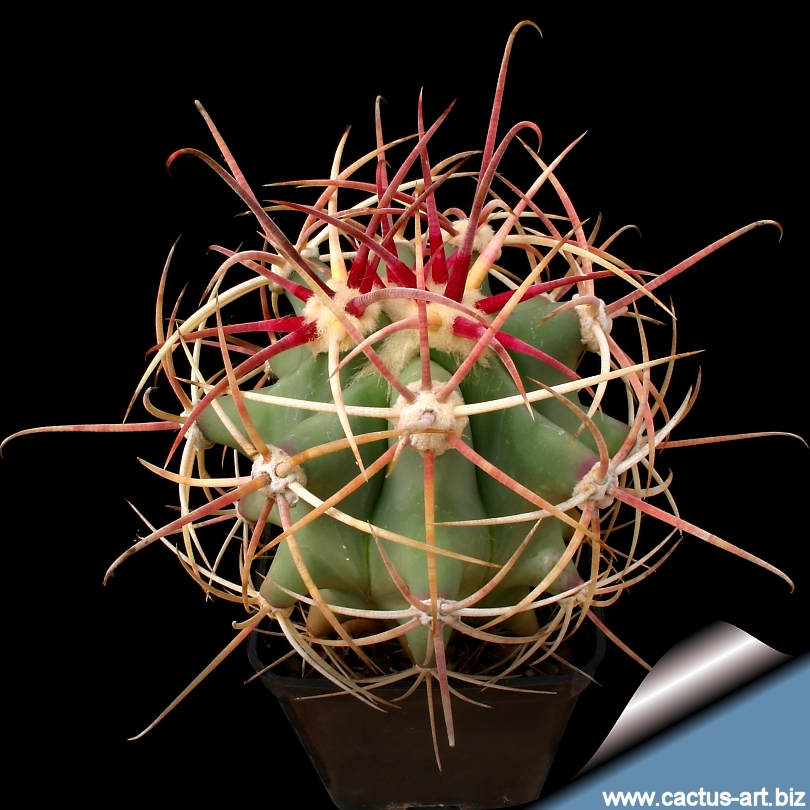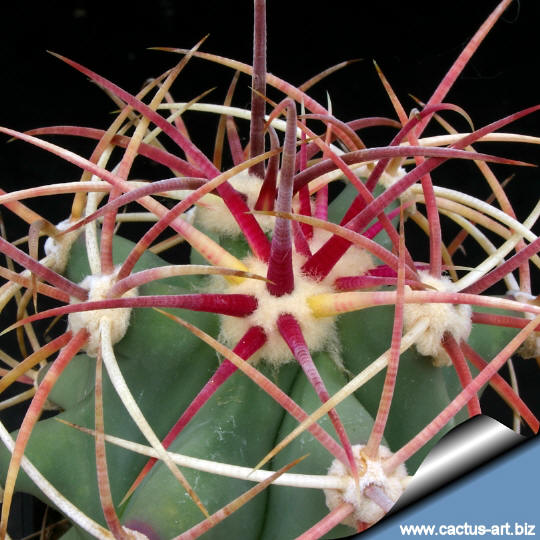|
|
|

Ferocactus covillei ( = emoryi)
The clean, sparsely spined appearance leads to a very attractive
plant. The spines sit on prominent nipples when young which will fade
into the rib with age.
The species name
F. covillei was used to indicate the plant originary found
in southwestern Arizona, but they are in fact almost identical and not
distinguishable from F. emoryi to which this plant must be
rightly placed.
Etymology: Covillei - For F.V. Coville (1867-1937), botanist and
curator of U.S. National Herbarium. Coville was the botanist for the
1893 Death Valley Expedition.
|
|
Description:
F. covillei( = F. emoryi) is a solitary
barrel cactus except in case of injury to the growing tip, it lacks the
lower radial spines of F. wislizenii and
F. acanthodes but has similar heavy, ridged, hooked central
spines.
Stems: Erect, globular when young to a stout cylinder when older,
30-90(-250) tall × 30-60 (100) cm in diameter; tubercled when young
later forming ribs.
Ribs: (15-)21-32, shallowly notched immediately above each
areole.
Areoles: oval with brown wool, 2-2.5 cm apart.
Spines: 6-10 per areole, reddish, reddish grey, or horn colored,
all robust and rigid, more than 1 mm diam.;
Central spine: 1, curved slightly to fully hooked, (hooked only
on relatively young plants), heavy, roughly cross-ribbed,
annulate, thick, adaxially flat, 55-95(-130) long × 2.5-4 mm. in
cross section.
Radial spines: 5 to 9 similar to central, spreading, not hooked,
2.5 to 5cm long.
Flowers: Reddish outside, brilliant red inside, 6-7.5 × 5-7.5 cm;
inner tepals brilliant red [or occasionally yellow]; stigma lobes
brilliant red.
Fruits: Persistent, oblong, scaled, 2,5-5cm long × 25-35 mm long
in diameter with the dried remains of the flower atop, ± readily
dehiscent through basal pore, bright yellow, 50, leathery or fleshy,
locule dry, hollow except for seeds. Often the fruit are broken into and
the seed eaten by birds or rodents.
Seeds: 2 mm. in diameter, black. |
|
Reproduction:
Seeds are the only way of
reproducing.
Attention: The spines that
hook around can graph you if you get too close.
|
|


Advertising
|
|
|
|
|
|
Family:
Cactaceae
(Cactus
Family)
Scientific Name: Ferocactus
emoryi ssp. emoryi (Engelmann) Orcutt,
Published in: Cactography. 1926(1): 5. 1926.
Basyonim: Echinocactus emoryi Engelmann
Published in: Proc. Amer. Acad. Arts 3: 275. 1856.
Synonyms:
- Echinocactus covillei Berger1829
- Ferocactus covillei Britton & Rose 1922
Common Names: Emory’s barrel cactus, Coville’s
barrel cactus
Origin: It is native of the lower deserts of
Arizona (Yuma, Pima and Maricopa Co.) and Mexico (Sonora).
Habitat: Hillsides, wash margins, alluvial fans, mesas, or
flats, gravely rocky or sandy soils, rocky slopes and adjacent bajadas,
Sonoran desert scrub, igneous substrates; 0-1200 m; Gravely, sandy, or
rocky soils of hillsides, alluvial fans, and wash margins at 450 to 750m
elevation.
Conservation status: Listed in
CITES appendix 2.
Note: Ferocactus emoryi has a confused taxonomic history.
The name is based on Echinocactus emoryi, which was published
twice by Engelmann, each involving a different species. Engelmann’s
first use of E. emoryi [in W. H. Emory]---applied to a population
of Ferocactus wislizeni in eastern Arizona---is rejected as
provisional and therefore invalid. However, Engelmann’s second use of
E. emoryi was a valid publication, and it unambigously pertains to
the species in southwestern Arizona that Britton and Rose unncecessarily
re-named as Ferocactus covillei.
|
|
|
|

The young spines have a
great looking red.
|
|
Cultivation: Slow growing to start but does well
under cultivation. Use very
draining soil, water during the aestival growth cycle (this plant
need plenty of water) But needs to be avoided wetting the bodies
of these plants while they are in sunlight. A wet cactus in the sun
light can cause sun burning which can lead to scares or even fungal
infections and death.
Needs full sun. Keep dry at 10°C in winter,
but can tolerate sporadic light frost.
Photo of conspecific taxa, varieties, forms and cultivars of
F. emoryi.
|
|